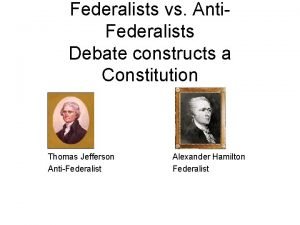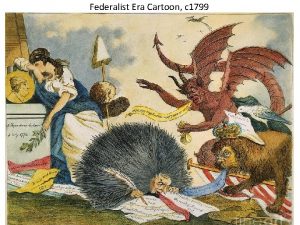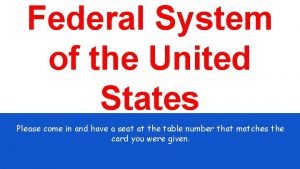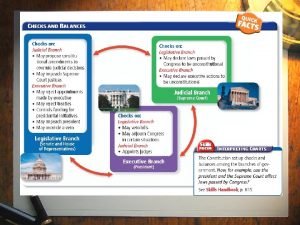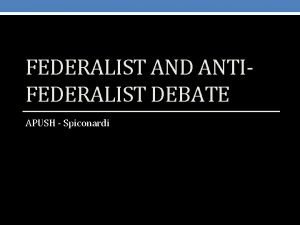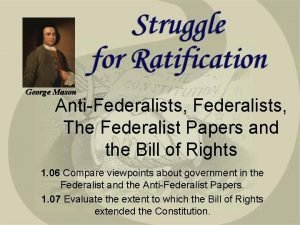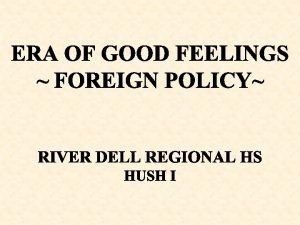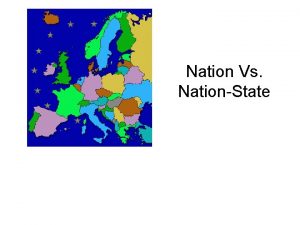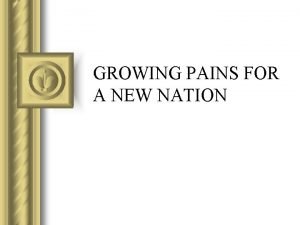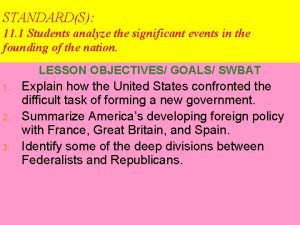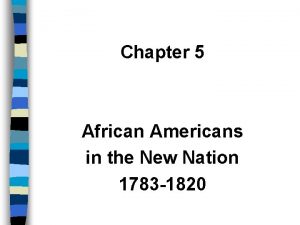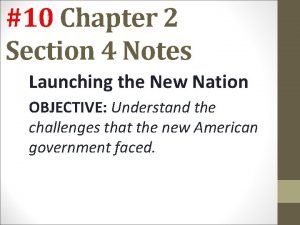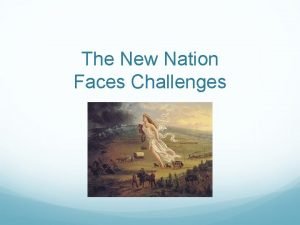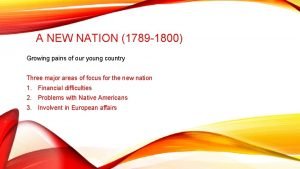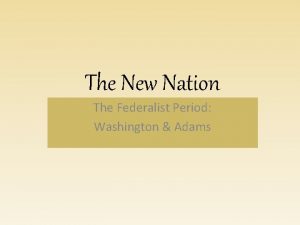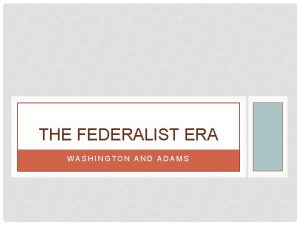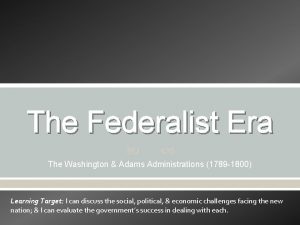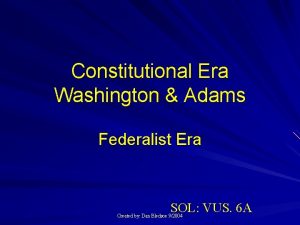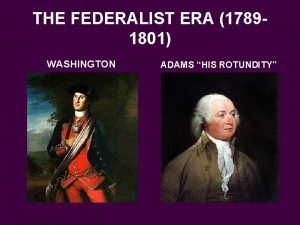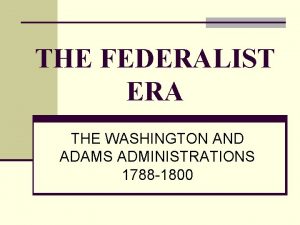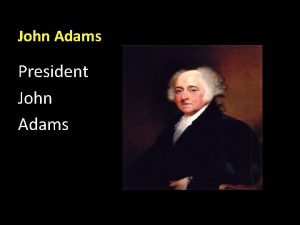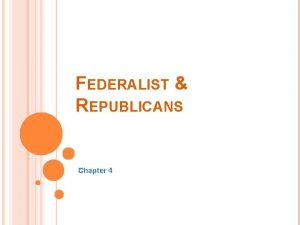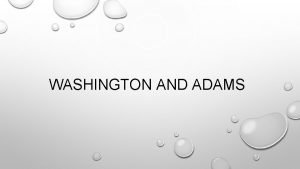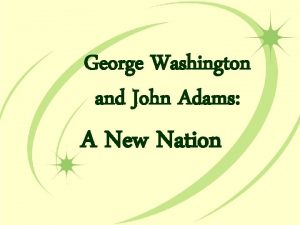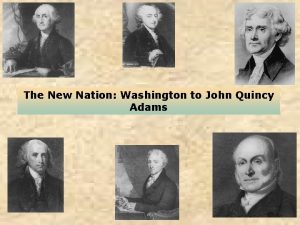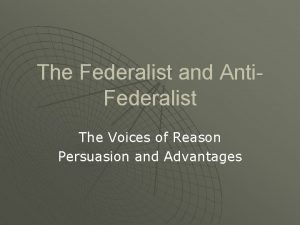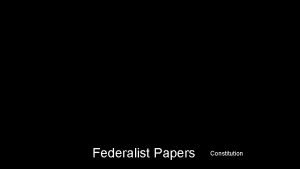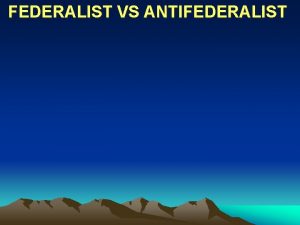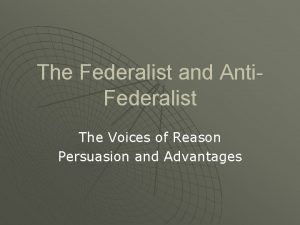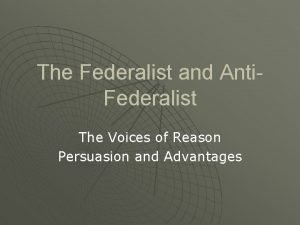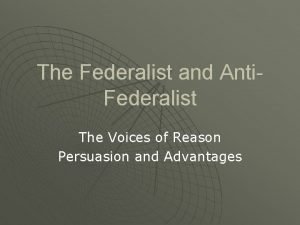The New Nation The Federalist Period Washington Adams























- Slides: 23

The New Nation The Federalist Period: Washington & Adams

Main Objectives: 1. Assess the impact of major domestic issues and conflicts in the US from 17891820. Explain the significance of George Washington's role as the first president and list the achievements of his presidency. Describe domestic and foreign issues during John Adams’ presidency. Discuss the importance of the Election of 1800. 2. 3. 4. First American Flag Hamilton Jefferson John Marshall Madison Washington Chief Little Turtle Aaron Burr John Adams

Washington is chosen as our first president. • Why Washington? – Leader of the Continental Army during the Revolution – Most Americans had confidence and trust in Washington – Washington’s Vice President was John Adams of Massachusetts

• Domestic Issues of Washington’s Administration

Establishing the Judiciary • Judiciary Act of 1789: Established the federal court system, made up of the Supreme Court, Federal District Courts, & Circuit Courts of Appeals. – 1 st Supreme Court had six justices – John Jay was appointed the first Chief Justice of the Supreme Court

Washington as President • Created the first Cabinet: a group of advisors to assist the president in making policy decisions. – First Cabinet consisted of 4 Departments • Department of State – Thomas Jefferson • Department of Treasury – Alexander Hamilton • Department of War – Henry Knox • Attorney General – Edmund Randolph * The cabinet was Washington’s creation, it was not mentioned in the Constitution. * Tried to balance regional viewpoints and differing opinions, however a riff develops between Hamilton and Jefferson

Securing the Nation’s Finances • The US started out with a national debt of $52 million. • Sec. of Treasury Hamilton devised the following Financial Plan: – Assume states’ debts into the national debt (southern states did not like this because they had already paid most of their debts) – Create a National Bank (the Bank of the United States) to regulate state banks and align business interests with the federal government – Pass Excise Taxes: taxes on goods produced in the US – Pass Tariffs: taxes on imported goods, to raise revenue in addition to domestic taxes – Develop an economy based on manufacturing, rather than agriculture Alexander Hamilton

Disagreement over Hamilton’s Financial Plan • Southerners disliked the plan because most southern states had paid their individual debts – they would now be taxed to pay northern state debts • The Constitution did not grant the federal government authority to create a National Bank – Loose Construction vs. Strict Construction • Southern farmers thought the plan favored northern merchants at their expense • Rural farmers opposed the excise tax on whiskey • Debate over Hamilton’s Financial Plan would eventually lead to the formation of the first Political Parties in the US.

Hamilton’s Plan is Adopted • Despite objections by Sec. of State Thomas Jefferson, President Washington accepted Hamilton’s Plan – The nation’s capital would be moved from New York City to the District of Columbia as a compromise with Southern states – Jefferson was the first president to occupy the presidency in DC 1800 National Capitol in 1800 in District of Columbia

Formation of Political Parties • Federalists • – Founded by Alexander Hamilton – Believed in a strong central government – Wanted an economy based on manufacturing – Supported the creation of a National Bank – Supported Britain in its conflict with France – Believed educated elite should control government – Loose interpretation of the Constitution Democratic-Republicans – Founded by Thomas Jefferson – Believed in limited central government; strong state governments – Wanted an economy based on agriculture -“Agrarian” society – Believed the creation of the bank was unconstitutional – Supported French revolutionaries in the French Rev. – Believed “common” men should have say in government (property owners) – Strict interpretation of the Constitution

Whiskey Rebellion 1794 • An excise tax had been placed on whiskey to raise revenue • Pennsylvania farmers distilled grain into whiskey and felt the tax was unfair. They refused to pay the tax and were violent with tax collectors • President Washington sent in federal troops to collect the tax • Washington’s actions proved the power of the federal government over the states, and it’s power to enforce taxes

Native American Conflicts General “Mad” Anthony Wayne Great Britain offered weapons to Native Americans in the Ohio River Valley following the American Revolution to stop US expansion east. This led to armed conflicts between the US and Natives. • 1790 -91: Miami Confederacy led by Little Turtle Defeat US troops led by Arthur St. Clair in Ohio River Valley • 1794: Gen. Anthony Wayne defeats the Miami Confederacy at the Battle of Fallen Timbers • 1795: Treaty of Greenville: Native Americans gave up most of their lands in present day Ohio in exchange for yearly payments & goods. -opened Northwest Territory to American settlement -established trend of Native Americans giving up ancestral lands to the US government Ohio River Valley

• Foreign Issues of Washington’s Administration

French Revolution 1789 -French Revolution begins in France Federalists wanted to support Britain Democratic Republicans wanted to support France Washington issued the Neutrality Proclamation of 1793 which stated the US would not become involved on either side of the conflict • Washington established the foreign policy of Isolationism, which would keep the US out of foreign matters for the most part until World War I. • •

Important Foreign Treaties • Jay’s Treaty: (1794) John Jay was supposed to negotiate an end to Britain’s violation of American shipping, but Britain only agreed to vacate British forts in the Northwest Territorysomething they had agreed to several years earlier • Pinckney’s Treaty: (1795) Thomas Pinckney negotiated with Spain for American use of the Mississippi River and New Orleans for trade, and moved the northern boundary of Spanish Florida to the 31 st parallel

Washington’s Farewell Address • Decided not to run for a 3 rd term • Warned against making foreign alliances “ISOLATIONISM” • Warned against the formation of political parties because he thought they would harm the government. *Federalist & Democratic-Republican parties had already formed during Washington’s administration.

Washington’s Presidential Legacy 1. Only president unanimously elected by the Electoral College 2. Established the first Cabinet 3. Used military force to establish national supremacy during Whiskey Rebellion 4. Established two-term tradition for future presidents 5. Began foreign policy of Isolationism 6. Warned against political parties

Election of 1796 John Adams Thomas Jefferson Candidates: • John Adams - Federalist • Thomas Jefferson – Democratic Republican • Adams narrowly defeated Jefferson & became president • Jefferson won the 2 nd most votes & became vice president • The president and vice president belonged to different political parties which led to conflict

1 st Amendment Speech Press Immigrant Alien & Sedition Acts 1798 John Adams’ Administration Alien Act: allowed government to deport immigrants for being critical of the government. Immigrants must live in the US 14 years before they can become citizens *most immigrants became members of the Democratic-Republican Party* Sedition Act: made it illegal to criticize or discredit the federal government either in written or oral form *intended to silence Democratic. Republican criticism of the Federalist government*

Virginia & Kentucky Resolutions 1. Written by Thomas Jefferson & James Madison 2. Response to the Alien & Sedition Acts 3. Introduced the idea of NULLIFICATION : *states can refuse to enforce federal laws they deem to be unconstitutional* 4. Based on idea of protecting States’ Rights 5. Most states did not join in with the Resolutions, which disappointed the authors Jefferson & Madison – Authors of the Virginia and Kentucky Resolution as a response to the Alien & Sedition Acts.

XYZ Affair • France was upset over American neutrality during the French Revolution & Jay’s Treaty. • France began seizing American ships in 1796 • President Adams sent diplomats to meet with French Prime Minister Talleyrand • 3 low-level French officials (X, Y, & Z) demanded a bribe of $250, 000 from the US • Americans were angered & called for war • Army & navy were expanded and there were battles between US and French warships (though war was never declared) • Adams remained Isolationist, refused to declare war, & eventually sent new diplomats to France to make peace, which hurt him in the Election of 1800

Election of 1800 1. 2. 3. 4. Despite increasing unpopularity, John Adams ran for re-election in 1800 Thomas Jefferson opposed Adams in the election Thomas Jefferson ran with a running-mate: Aaron Burr Jefferson & Burr tied in votes in the Electoral College forcing the election into the House of Representatives 5. Jefferson was elected president by the House in 1800 • Jefferson claimed the Election of 1800 was a “Revolution” – it was the first peaceful transfer of government power from one political party to another • 12 th Amendment was passed in 1804 to change the voting process in the Electoral College requiring electors to vote for president & vice president separately

Adams Leaves Office Adams’ final act in office: Midnight Appointments – created new federal judgeships with the intention of appointing Federalist judges to ensure Federalists controlled at least one branch of government Adams’ act led to Marbury v. Madison (1803) in which John Marshall ruled part of the Judiciary Act of 1789 was unconstitutional. The concept of JUDICIAL REVIEW was established, which allowed the Supreme Court to rule on the constitutionality of laws and Congressional actions Thomas Jefferson’s election marked an end to the Federalist Era.
 Federalist vs anti federalist
Federalist vs anti federalist Federalist cartoons
Federalist cartoons Federalism cartoon explanation
Federalism cartoon explanation Federalist or anti federalist quiz
Federalist or anti federalist quiz Federalist vs anti federalist apush
Federalist vs anti federalist apush George mason anti federalist
George mason anti federalist Define john quincy adams
Define john quincy adams John adams vs thomas jefferson venn diagram
John adams vs thomas jefferson venn diagram State vs nation
State vs nation Nation vs state
Nation vs state Theories of origin of state
Theories of origin of state A new nation and its growing pains review
A new nation and its growing pains review Creating a new nation
Creating a new nation Chapter 5 african american in the new nation
Chapter 5 african american in the new nation Chapter 2 section 4 launching the new nation
Chapter 2 section 4 launching the new nation The new nation faces challenges
The new nation faces challenges Growing pains for the new nation
Growing pains for the new nation Critical period vs sensitive period
Critical period vs sensitive period A&p flix activity: generation of an action potential
A&p flix activity: generation of an action potential Absolute refractory period and relative refractory period
Absolute refractory period and relative refractory period Critical period vs sensitive period
Critical period vs sensitive period Critical vs sensitive period examples
Critical vs sensitive period examples Approaches to child development
Approaches to child development 1750s music
1750s music
